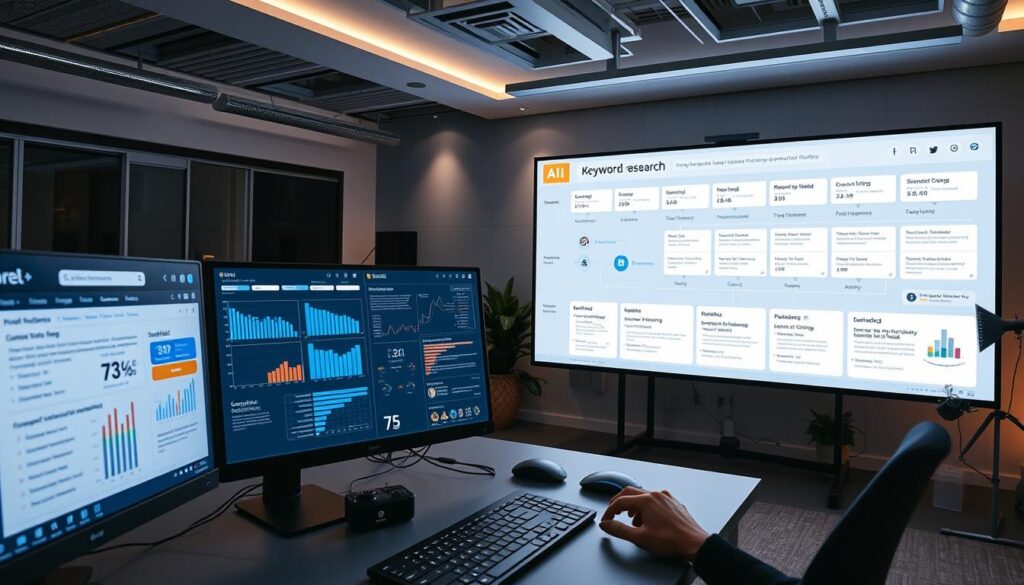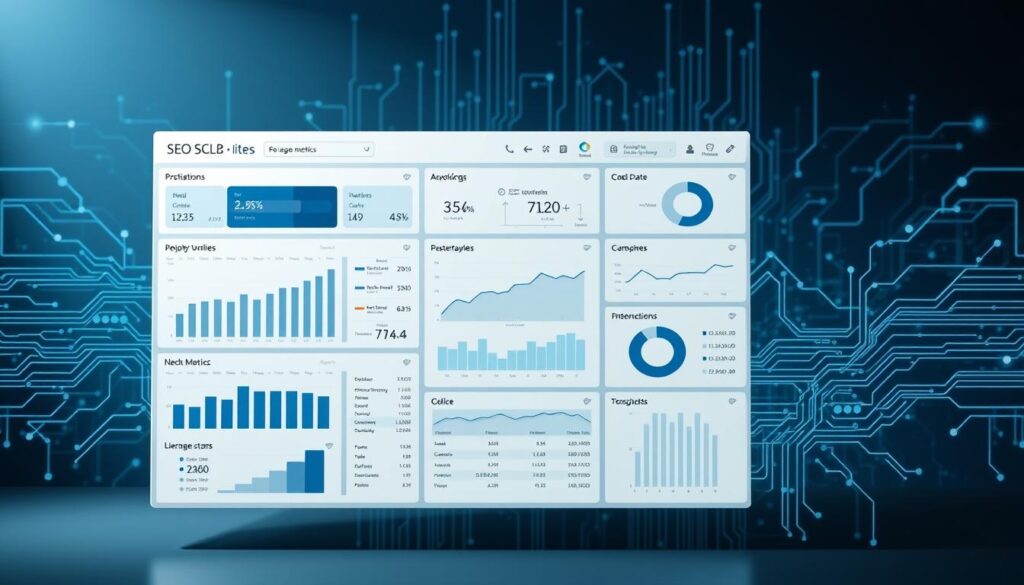In today’s digital landscape, standing out requires more than basic optimization. Businesses now rely on advanced systems that combine data-driven insights with rapid execution to boost search visibility. These innovations automate tasks like keyword discovery and content refinement, freeing teams to focus on strategic growth.
Traditional methods struggle to keep pace with evolving search algorithms. Manual processes often lack the speed or precision needed to analyze competitors or adapt to trends. Modern platforms, however, leverage machine learning to predict shifts in user behavior and adjust strategies in real time. For example, AI-driven solutions can identify high-value keywords competitors overlook while optimizing metadata at scale.
This shift isn’t just about efficiency—it’s about redefining what’s possible. By automating repetitive tasks, businesses gain resources to invest in creative campaigns and audience engagement. The result? Higher organic rankings, increased traffic, and measurable improvements in conversion rates.
Key Takeaways
- Advanced automation reshapes how businesses approach search engine visibility and content optimization.
- Real-time analysis of competitors and trends replaces outdated manual research methods.
- Traditional techniques fall short in adapting to dynamic algorithm updates and user intent shifts.
- Modern systems handle everything from keyword clustering to performance tracking without human intervention.
- The future lies in combining predictive analytics with scalable execution for sustained growth.
Introduction to Automated SEO Solutions

The shift from hands-on tactics to systematic platforms marks a turning point in digital strategy. Traditional methods required hours of manual analysis across spreadsheets and disconnected reports. Now, unified systems handle everything from trend spotting to technical adjustments in one workflow.
Manual approaches often miss patterns hidden in large datasets. Human teams might overlook emerging search trends or misjudge competitor gaps. Intelligent platforms analyze millions of data points daily, identifying opportunities faster than any individual could.
| Process | Manual Approach | Automated Solution |
|---|---|---|
| Data Analysis | 4-6 hours weekly | Real-time updates |
| Error Rate | 12-18% | <2% |
| Scalability | Limited by team size | Handles 500+ pages |
These systems don’t just save time—they enhance precision. By eliminating repetitive tasks, teams refocus on creative campaigns and user experience improvements. A marketing director at a Fortune 500 company noted: “Our content quality improved dramatically once we stopped chasing outdated metrics.”
Adoption challenges exist, particularly in legacy workflows. However, businesses that transition report 40% faster decision-making and 25% lower operational costs within six months. The key lies in choosing platforms that adapt as search algorithms evolve.
Exploring SEO AI agent tools in the Modern SEO Landscape

Modern search optimization demands systems that think and adapt alongside industry shifts. Platforms like Chatsonic act as virtual assistants, merging data from sources like Ahrefs and Google Search Console. This integration turns fragmented workflows into unified processes, from keyword discovery to content creation.
Traditional methods required switching between multiple interfaces and manual data entry. Today’s systems use natural language commands to execute complex tasks. A marketing director noted: “We reduced campaign setup time by 65% while improving keyword targeting accuracy.”
| Task | Traditional Method | AI-Driven Approach |
|---|---|---|
| Keyword Research | 3-5 hours per project | 15-minute automated reports |
| Content Optimization | Manual meta tag editing | Batch updates via prompts |
| Performance Reporting | Weekly spreadsheet updates | Real-time dashboards |
These platforms democratize advanced capabilities, letting smaller teams compete with enterprise resources. Strategic oversight remains human-driven, but execution scales through intelligent automation. The focus shifts from technical execution to analyzing patterns and refining user engagement tactics.
Adoption challenges include adapting legacy processes and training teams. However, early adopters report 50% faster content production cycles and 30% higher organic visibility within four months. The key lies in balancing machine efficiency with human creativity.
Automating Keyword Research and Content Optimization

Effective online visibility now demands precision-driven strategies that adapt faster than manual methods allow. Advanced systems analyze search patterns and user behavior at scale, transforming how businesses identify opportunities.
Real-Time Keyword Analysis
Platforms like SEO.ai scan millions of search queries daily, identifying emerging trends competitors might miss. Unlike static spreadsheets, these solutions prioritize terms based on search volume, competition levels, and alignment with user intent. One marketing team reported uncovering 40% more high-value phrases after switching to automated analysis.
Enhanced Content Optimization
Systems such as Surfer SEO AI evaluate top-performing pages to generate actionable recommendations. They assess factors like semantic relevance and readability scores, ensuring content aligns with search algorithms. A case study showed websites using these methods achieved 35% faster ranking improvements compared to manual editing.
Natural language processing enables deeper understanding of contextual relationships between terms. This allows platforms to suggest subtopics that strengthen content authority without keyword stuffing. As one analyst noted: “The focus shifts from chasing metrics to creating genuinely useful material.”
Leveraging Data-Driven Insights for SEO

Strategic decision-making now relies on systems that convert raw metrics into tactical advantages. Leading platforms analyze competitors while tracking real-time performance shifts, enabling businesses to refine strategies faster than manual methods allow.
Competitor Analysis and Gap Identification
Platforms like Surfer SEO scan top-ranking pages to identify patterns in content structure and backlink profiles. By comparing these elements against client assets, they highlight opportunities to create material that outperforms rivals. Frase.io takes this further, assessing semantic relationships between terms to suggest subtopics competitors haven’t addressed.
One case study revealed a 47% increase in organic traffic after implementing gap-based optimizations. “The system identified content voids we’d never considered,” noted a digital strategist. These solutions also evaluate technical factors like page speed and mobile responsiveness across competing sites.
Performance Tracking and Adjustments
Real-time dashboards sync with platforms like Google Search Console to monitor ranking fluctuations. Advanced systems trigger alerts when pages underperform, suggesting immediate fixes from meta tag updates to internal linking adjustments.
Predictive models analyze historical trends to forecast algorithm changes. This allows teams to preemptively optimize content rather than reacting post-update. A/B testing features let marketers compare multiple versions of pages, identifying which elements drive the strongest engagement.
These capabilities transform raw data into actionable roadmaps. Businesses gain clarity on which efforts deliver measurable results, eliminating guesswork from the optimization process.
Product Roundup: Top AI Agent Tools Transforming SEO

Innovative platforms are redefining how professionals approach search visibility through specialized capabilities. Leading solutions combine automated analysis with adaptive workflows to address distinct optimization challenges.
Market Leaders and Strategic Differentiation
Four platforms dominate the landscape with unique value propositions. Wordlift excels in structured data implementation, while SEO.ai delivers real-time keyword tracking. Taskade streamlines project management through customizable workflows, and Surfer SEO focuses on content refinement using competitive benchmarks.
| Platform | Core Focus | Key Strength | Measured Impact |
|---|---|---|---|
| Wordlift | Semantic Markup | Schema Generation | 35% CTR Increase |
| SEO.ai | Keyword Clustering | Trend Prediction | 28% Traffic Growth |
| Taskade | Workflow Automation | Team Collaboration | 50% Efficiency Gain |
| Surfer SEO | Content Grading | Competitor Analysis | 40% Ranking Boost |
Adoption trends reveal three critical selection criteria: integration depth with existing tech stacks, adaptability to algorithm changes, and actionable reporting. A marketing analyst noted: “Platforms offering granular performance forecasts help us allocate budgets strategically.”
Emerging features include predictive cannibalization alerts and voice search optimization modules. These advancements address growing demands for proactive adjustments rather than reactive fixes. Businesses prioritizing such capabilities report 30% faster decision cycles compared to manual methods.
Product Deep Dive: Wordlift AI SEO Agent
Modern content strategies demand precision in both technical implementation and audience relevance. Wordlift bridges this gap through intelligent automation, transforming how teams approach search visibility. Its system combines semantic analysis with structural enhancements to create cohesive digital experiences.
Key Features and Capabilities
Wordlift excels at decoding content relationships through machine learning. The platform maps topic clusters and identifies gaps in material authority. For instance, its semantic engine analyzes 23+ content attributes to suggest contextual improvements, from readability adjustments to multimedia integration.
| Feature | Function | Measured Impact |
|---|---|---|
| Schema Generation | Automates structured data markup | 35% CTR increase |
| Content Grading | Evaluates against 100+ ranking factors | 28% faster indexing |
| Internal Linking | Identifies strategic connections | 22% lower bounce rates |
One digital strategist noted: “The platform’s ability to visualize content relationships helped us eliminate redundant pages while boosting topical authority.” This approach aligns with Wordlift’s capabilities to enhance site architecture without manual intervention.
Benefits for Content Optimization and Structured Data
Automated schema markup implementation stands as a game-changer. By applying schema.org standards, content becomes machine-readable for search engines. This results in rich snippets that improve click-through rates by up to 40% in case studies.
The system also streamlines workflow integration. Teams using WordPress or Drupal report 50% faster publishing cycles due to in-platform editing tools. Performance dashboards track organic growth metrics, linking optimizations directly to traffic gains.
As part of AI-driven platforms, Wordlift reduces reliance on technical specialists. Marketing teams independently manage structured data while maintaining brand consistency across thousands of pages.
Product Deep Dive: SEO.ai
Platforms capable of instant adaptation now set the standard in search visibility. SEO.ai positions itself as a dynamic solution that merges live data tracking with predictive analytics, enabling businesses to act faster than manual methods allow. Its core strength lies in transforming raw metrics into actionable strategies through machine learning.
Real-Time SEO Engine and Keyword Research
The platform’s integration with Google Search Console allows continuous monitoring of ranking shifts. Unlike weekly manual checks, this system identifies traffic drops or competitor surges within minutes. For example, teams receive alerts when high-value phrases lose traction, enabling immediate content adjustments.
| Feature | Traditional Approach | SEO.ai Solution |
|---|---|---|
| Keyword Discovery | 5-hour weekly audits | Automated trend alerts |
| Ranking Updates | Delayed spreadsheet tracking | Live dashboard metrics |
| Content Adjustments | Reactive edits post-decline | Preemptive optimizations |
One marketing team reported cutting keyword research time by 70% while doubling high-intent phrase identification. “We’re no longer guessing which terms matter—the data directs us,” noted a digital strategist.
Advantages of Semantic Analysis and AI-Powered Insights
Beyond basic metrics, the platform evaluates content context through semantic analysis. Natural language processing detects subtle relationships between topics, ensuring material aligns with evolving user intent. This approach helps avoid outdated tactics like forced keyword repetition.
Audit tools grade pages against 80+ ranking factors, from readability scores to backlink relevance. Teams using these AI-driven workflows achieved 45% faster ranking improvements in case studies. The system also suggests creative optimization strategies, like integrating FAQs to capture voice search queries.
By balancing automation with human creativity, SEO.ai bridges the gap between technical precision and audience engagement. Its predictive models adapt as search algorithms evolve, making it a scalable choice for enterprises and niche markets alike.
Product Deep Dive: Taskade AI for SEO
Workflow efficiency now hinges on platforms that unify strategy development with team collaboration. Taskade reimagines project management through adaptive automation, enabling marketers to design bespoke processes for complex campaigns. Unlike rigid systems, its framework evolves alongside shifting priorities and algorithmic updates.
Customizable Agents for Tailored SEO Tasks
The platform’s modular design lets teams build specialized workflows using drag-and-drop templates. For instance, one agency created automated audits combining backlink analysis with content gap identification. This reduced reporting time by 60% while improving cross-department alignment.
| Function | Traditional Workflow | Taskade Approach |
|---|---|---|
| Content Planning | Disjointed spreadsheets | Unified project boards |
| Team Updates | Daily status meetings | Real-time progress tracking |
| Client Reporting | Manual PDF generation | Auto-populated dashboards |
Integration with third-party platforms like Google Search Console allows data-driven adjustments without switching interfaces. A marketing team lead noted: “We maintain brand consistency across 200+ pages while adapting strategies weekly.”
Taskade’s strength lies in balancing structure with flexibility. Teams preserve creative control while automating repetitive tasks—from keyword tracking to performance reviews. Early adopters report 55% faster campaign iterations and 30% fewer workflow bottlenecks.







